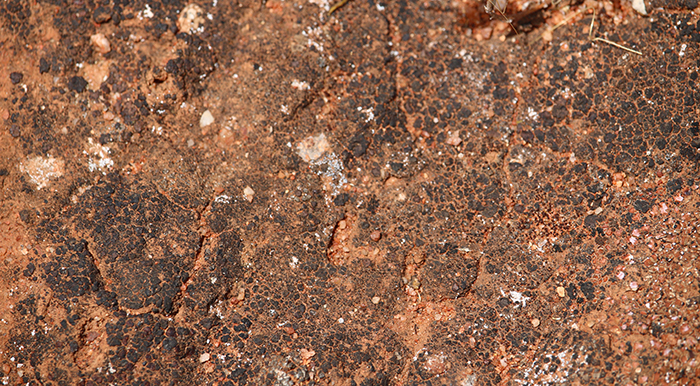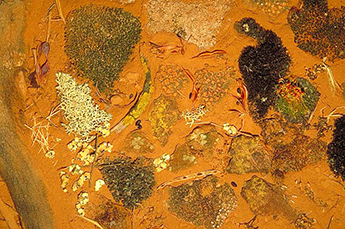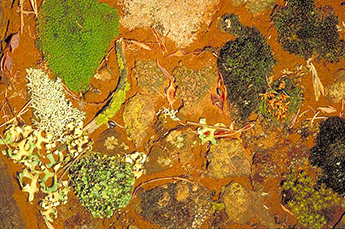And their importance for farm production and the environment.
Biological soil crusts are a layer of living organisms growing on the surface of undisturbed soils – particularly in dry environments – that play a significant role in protecting and enhancing the local environment.
They are formed by species of lichen, moss, cyanobacteria, algae and fungi, and their by-products, creating a crust of soil particles bound together by organic materials.
Biological crusts are concentrated in the top 1-4mm of the soil, are a sign of healthy, stable soils and play vital ecological roles in dry landscapes, including:
- stabilising soil against wind and water erosion. By providing a physical barrier on the soil surface, as well as excreting organic gels and polysaccharides into the soil, soil crusts cement soil particles into larger aggregates and reduce the soil’s erosion potential
- fixing atmospheric nitrogen and carbon
- trapping nutrients, water and seeds, making good sites for seeds to germinate and seedlings to establish
- improving water infiltration. Soil crusts provide stable passageways – produced by fungal hyphae and the rhizines of lichen – that enable water to move through the top few millimetres of soil
- providing habitat for microfauna, including springtails and mites, that are important for decomposition and mineralisation processes in the soil
- regulating soil surface temperature. Different soil crusts reflect solar radiation at different rates, which has a significant impact on the surface temperatures. Changes in the soil surface temperature can affect the localised rates of nitrogen and carbon fixation, microbial activity, plant nutrient uptake and growth, soil water evaporation and seed germination.
- trapping nutrient rich dust. This dust can increase the amount of most plant-essential nutrients up to four times, thereby increasing the fertility of the soil
- affecting plant species growth. Different soil crusts have different characteristics. Some soil crusts are smooth and don’t allow localised infiltration of water, while other soil crusts are rough and significantly increase the infiltration of water. These different soil crusts affect the plant species that grow in a specific location.

Biological soil crust
Plant tissue tests have shown the presence of several nutrients increases in plants grown in soil with crusts, while crusts have also been shown to improve plant survival, when compared to plants growing in bare soil.
Biological soil crusts in dry environments are able to survive complete desiccation, but they are highly susceptible to damage from motor vehicles, grazing animals and even hikers. Trampling breaks down the strong organic bonds that give crusts their stability. A single car driving over a soil crust can reduce the capacity of the crust to produce nitrogen by up to 92%.
Fencing off remnant vegetation from stock is vital to ensuring the biological soil crusts can continue to look after the health of your remnant patches. Leaving a highly disturbed (or even destroyed) biological soil crust undisturbed for an extended period will allow the soil crust to slowly return and help your bushland to regenerate naturally. This can take from months to decades, depending on the length of time the area has been disturbed, the local biological crust species present and the level of activity that occurred within the remnant vegetation patch.
If you are unable to fence off your remnant vegetation, or if you are in the rangelands you can help protect your biological soil crusts by:
- having a sacrificial paddock, within which drought feeding of stock can occur, so that degradation is confined to small areas
- providing more watering points, so that stock are dispersed over larger areas, thereby reducing the risk of damage to biological soil crusts
- reducing stocking rates in areas with biological soils crusts.
 |
 |
The photographs above (taken by Heino Lepp) are of a selection of different biological soil crust species collected from different environments in western New South Wales. The photo on the left shows the soil crusts in their desiccated form, while the photo on the right shows them a minute or two after having water poured on them. A crust that appears dead for months at a time will quickly spring back to life after rain.
Reference
Ecology: Biological soil crusts (Australian National Botanic Gardens)


